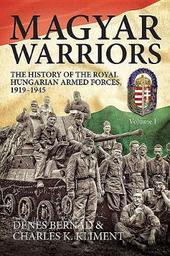
|
Magyar Warriors, Volume 1: The History of the Royal Hungarian Armed Forces 1919-1945
Paperback
Main Details
| Title |
Magyar Warriors, Volume 1: The History of the Royal Hungarian Armed Forces 1919-1945
|
| Authors and Contributors |
By (author) Denes Bernad
|
| Physical Properties |
| Format:Paperback | | Pages:404 | | Dimensions(mm): Height 245,Width 170 |
|
| Category/Genre | Military history |
|---|
| ISBN/Barcode |
9781912174164
|
| Classifications | Dewey:355.0094390904 |
|---|
| Audience | | Professional & Vocational | |
|---|
| Illustrations |
c 550 b/w photos, 43 tables, 13 maps
|
|
Publishing Details |
| Publisher |
Helion & Company
|
| Imprint |
Helion & Company
|
| NZ Release Date |
15 July 2018 |
| Publication Country |
United Kingdom
|
Description
The Hungarian armed forces (known as the Honvedseg) were built up in the 1930s, their expansion gaining momentum once Hungary became free of the strict post-WWI Trianon treaty limitations in August 1938. Politically, Hungary was looking for a strong ally, who would help it to recover at least some of the territories containing sizeable Magyar ethnic populations that had been lost after the First World War. Initially, in the mid-1930s, Italy gave political assistance and supplied military materiel, then - on the eve of WWII - Germany also lent support. In November 1938, Hungary managed to peacefully recover a chunk of its former territory from Czechoslovakia, followed by the Sub-Carpathian area during a brief border war in March 1939, then the northern part of Transylvania from Rumania in August 1940. Later, in April 1941, the Bachka region and parts of Baranya were also taken back from the dismembered Yugoslavia, in a swift military action. The rub was that Hungary was sucked into the cauldron of the Eastern front, and soon the Honveds (Hungarian soldiers) found themselves deep in Soviet territory, outgunned and outnumbered by the Red Army. Later on, from August 1944, the beleaguered Honvedseg had to fight against the mighty Soviet army in defense of its own territory. Alongside tiny Croatia, Hungary remained the last German ally up to the bitter end. This comprehensive reference, to be published in three volumes, and the fruit of over twenty years of meticulous research, strives to provide a complete picture of the Hungarian armed forces between the years 1919-1945. It starts with a brief history of the Magyars, describes the political situation in Hungary before and during WWII, the building of the armed forces, the growth of domestic arms manufacturers, the organization of the armed forces units and how they changed during the war. The various campaigns of the war are described in great detail, illustrated with many photographs and maps. This, the first volume, contains approximately 550 photographs, many previously unpublished, as well as numerous tables and maps of the various campaigns. The authors drew on official Hungarian and German archives, and a multitude of private sources, both from individuals living in Hungary and Hungarian emigres from the Western Diaspora. The result of this herculean effort is a three-volume series destined to be the reference work on the topic, a must for people fascinated by military history, or generally interested in the 1100-year-long rich history of Hungary and its Magyar Warriors.
Author Biography
Dipl. Eng. Denes Bernad was born in 1964 in Transylvania (Rumania), in a family of indigenous ethnic Hungarians. He studied at the Transylvanian University in Brasov, where he graduated in 1988 as a Mechanical Engineer. From 1992 he lived in Canada, and in 2006 he returned with his family to Hungary. Currently, he works in the automotive industry as Program Launch Manager. He is fluent in three languages. His main interest is the military history of Central and Eastern Europe, especially Rumania, Hungary and Bulgaria. His books deal especially with air forces and aircraft of these countries. He has written or co-authored seventeen historical books. Aside from the above books, Denes Bernad has published many studies concerning the history of aviation in Air Enthusiast, Air International and FlyPast (UK), WW1 Aero (USA), Avions (France), Repules, Aero Historia and Uj Szarnyak (Hungary), Militaria and Skrzydlata Polska (Poland) and Aeronatica, Aeromagazin and Model-Ist (Rumania). He is also the founding member of the Asociatia pentru Propagarea Istoriei Aviatiei (ARPIA) - Association for Propagation of History of Aviation (Bucharest, Rumania) and Magyar Repulestorteneti Tarsasag (MRT) - Hungarian Society of Aviation History (Budapest, Hungary). He is also a foreign correspondent of the French aviation magazine Avions.
|